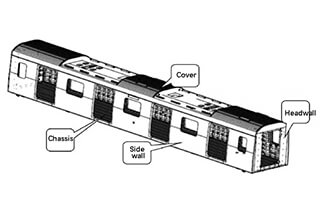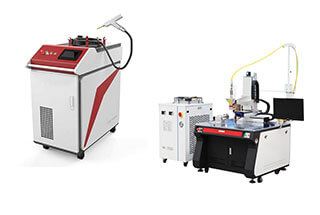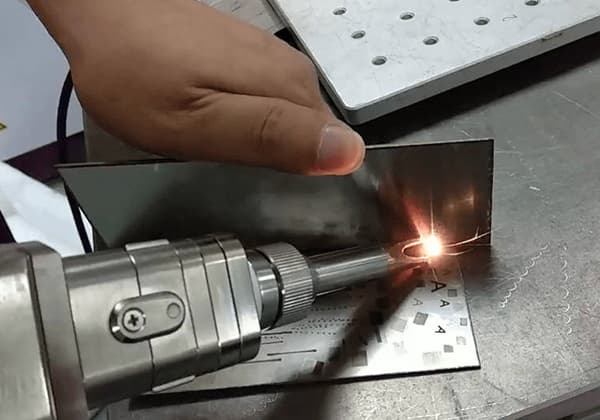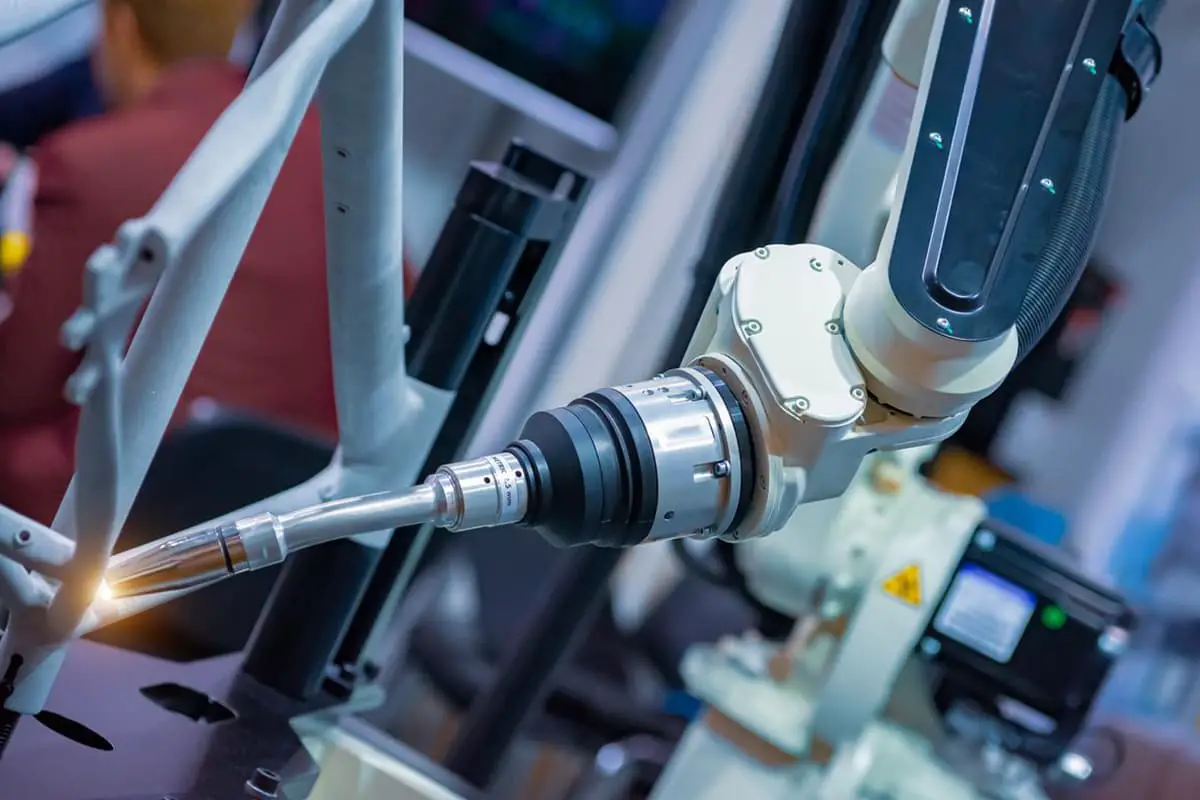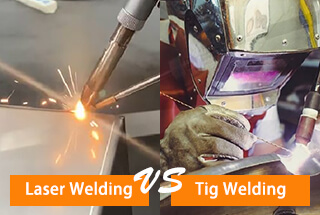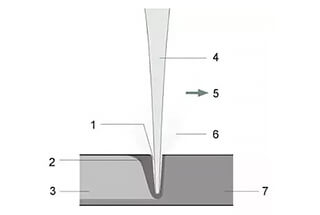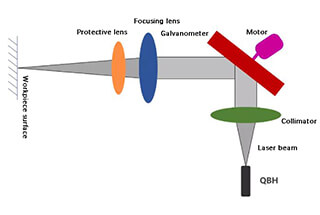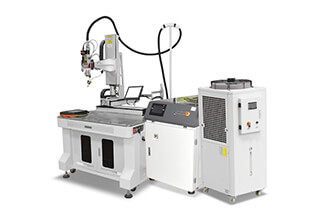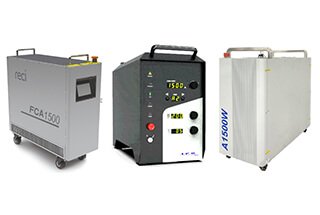
Have you ever wondered how handheld laser welding machines are revolutionizing the manufacturing industry? In this blog post, we’ll explore the intricacies of these cutting-edge tools and how they’re transforming the way we create and repair metal components. Our expert mechanical engineer will guide you through the benefits, applications, and key features of handheld laser welding machines, providing valuable insights that will keep you at the forefront of this exciting technology.
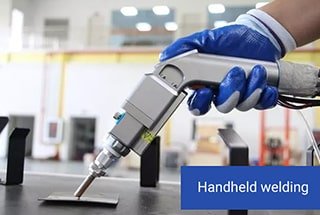
According to preliminary understanding, most stainless steel products are produced through argon arc welding and other conventional welding methods.
Although these methods can fulfill 80% of production requirements, they can result in defects in the welding products such as undercut, incomplete penetration, dense porosity, and cracks.
These defects not only reduce the joint’s strength, but also serve as the source of crevice corrosion.
The welding process requires not only the welder’s technical proficiency but also the high cost of flux, which increases production costs. Additionally, the post-welding processing steps are very slow.
Moreover, the working steps of processing after welding are very slow.
To address these issues, handheld fiber laser welding machines were introduced.
Handheld laser welding technology uses laser beams as the energy source to impact the welding joint and achieve welding.
It is a new welding method that has good welding performance, low deformation, and is widely used in the processing and welding of various metals.
The handheld laser welding machine has the advantages of ease of use, beautiful welding appearance, fast welding speed, and the absence of consumables.
It can perfectly replace traditional processes such as argon arc welding and electric welding for welding thin stainless steel sheets, iron sheets, galvanized sheets, and other metal materials.

Handheld laser welding machines can be used in a variety of industries that require complex, irregular welding processes, such as cabinets, kitchens, stairs, elevators, shelves, ovens, stainless steel doors and windows, guardrails, distribution boxes, and stainless steel homes.
The handheld laser welding machine has a fast welding speed, which is 2 to 10 times faster than traditional welding methods, and can save at least two welders per year.
The welding seam after laser welding is smooth and attractive, reducing the need for post-weld grinding, saving time and cost.
The laser-welded workpieces are free from deformation and welding scars and have a strong welding bond. Additionally, the handheld laser welding machine requires fewer consumables and has a long lifespan.
The machine is capable of welding various graphics, including points, lines, circles, squares, or any 2D shapes created using AutoCAD software.

I. What Is a Handheld Laser Welding Machine?
The handheld laser welding machine represents a cutting-edge advancement in laser welding technology, employing non-contact welding techniques. This innovative device utilizes a high-energy laser beam directed onto the material surface, eliminating the need for applied pressure during operation.
The welding process occurs through the precise interaction between the focused laser beam and the workpiece material. This interaction generates localized heat, causing the material to melt rapidly. As the molten pool cools and solidifies, it forms a strong, high-quality weld joint.
This portable system has revolutionized the laser equipment industry by transforming the traditional fixed-position laser welding paradigm. By integrating fiber laser technology with handheld maneuverability, it enables welding operations in diverse environments, including outdoor locations and at extended distances from the power source.
Key advantages of handheld laser welding include:
The handheld laser welding machine offers significant improvements over traditional welding methods, featuring:
These attributes make it an ideal replacement for conventional argon arc welding in various applications, particularly for thin metal materials including stainless steel, mild steel, and galvanized sheets.
The technology excels in welding large-scale workpieces and components at considerable distances, effectively addressing the limitations of stationary laser welding systems. This capability expands its applicability across diverse industries, from automotive and aerospace to general metal fabrication and repair services.
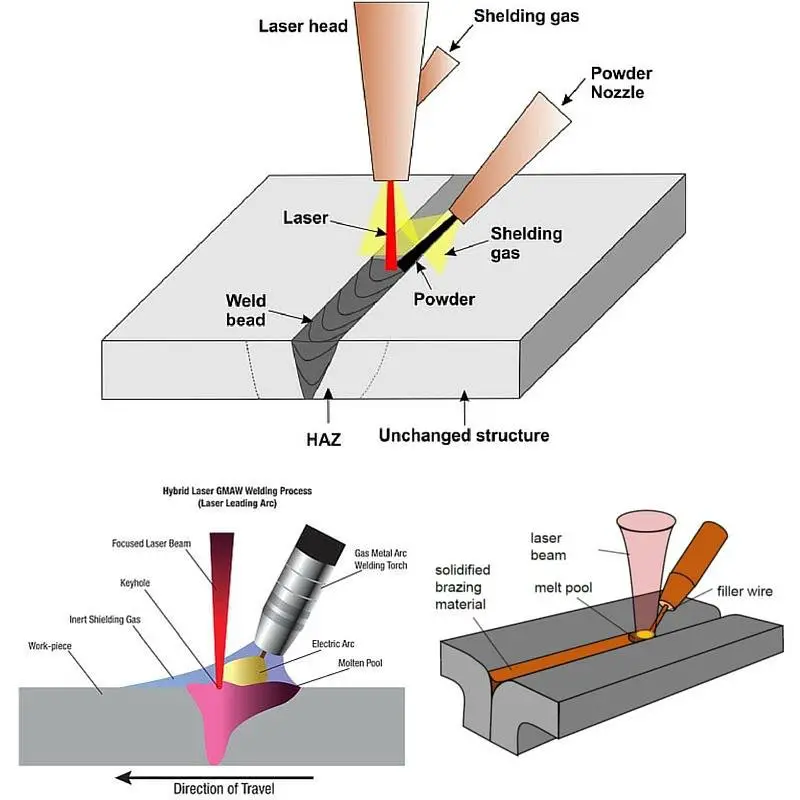
The working principle of a handheld laser welding machine revolves around the precise application of high-energy laser pulses to localized areas of the material. This concentrated energy is rapidly absorbed and conducted into the material’s interior, inducing localized melting and forming a molten pool.
Laser heat sources are characterized by their exceptional energy density, capable of focusing substantial power onto a minuscule area. This results in several advantages: high welding speeds, minimal heat-affected zones (HAZ), reduced welding deformations, and the ability to join thin plates with precision.
When the laser power density exceeds 106 W/cm2, the metal undergoes rapid heating to its vaporization point. This causes a steep temperature gradient at the surface, leading to metal vaporization. The resultant vapor pressure creates additional stress, causing the molten metal to depress and form a keyhole beneath the laser focal point.
As the laser continues to irradiate the material, the beam penetrates directly into the keyhole’s bottom, maintaining and deepening this cavity. The keyhole’s depth is governed by a dynamic equilibrium between the metal vapor’s recoil pressure, the liquid metal’s surface tension, and gravitational forces.
At high power densities, the keyhole can penetrate the entire plate thickness, resulting in a deep penetration weld. This keyhole moves along the welding direction in tandem with the laser beam’s motion relative to the workpiece. The metal ahead of the keyhole melts, flows around it to the rear, and rapidly solidifies to form the weld bead.
The keyhole welding mode enables the formation of narrow, deep welds with high aspect ratios. It’s particularly effective for welding materials with high thermal conductivity or reflectivity, as the keyhole traps the laser energy efficiently.
Handheld laser welding is primarily employed for joining thin-walled materials and precision components. Its versatility allows for various welding configurations, including spot welding, butt welding, lap welding, and hermetic sealing. The process offers excellent control over heat input, making it ideal for welding heat-sensitive materials or components with tight dimensional tolerances.
Modern handheld laser welding systems often incorporate real-time monitoring and adaptive control features to ensure consistent weld quality. These may include seam tracking, power modulation based on material thickness, and post-weld inspection capabilities.
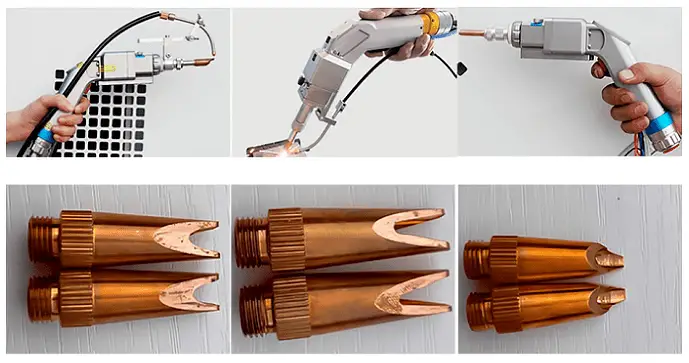
III. Why Use a Handheld Laser Welder?
Handheld laser welding machines are engineered for versatile applications, particularly excelling in welding large-scale workpieces and components with extensive linear dimensions. This advanced technology offers several key advantages over conventional welding methods:
These attributes make handheld laser welding machines an invaluable tool in modern manufacturing, fabrication, and repair processes, offering a combination of precision, flexibility, and ease of use that surpasses traditional welding techniques in many applications.
Performance comparison between laser welding and traditional welding
| Material | Depth-width ratio | Power density (W/cm2) | Thermal deformation | Welding quality |
| Metal, Non-metal | <10 | 10K-100M | Min | High quality; Single side welding reduces weight and has high welding strength |
| Metal | <2 | 100-1M | Remarkable | Double-sided welding increases weight and low welding strength |
| Metal | <2 | 1K-100K | Remarkable | Large weld joint; Increased weight and low welding strength |
| Metal, Non-metal | <30 | 1M-100M | Min | High quality; However, the process is complex and requires vacuum and degaussing |
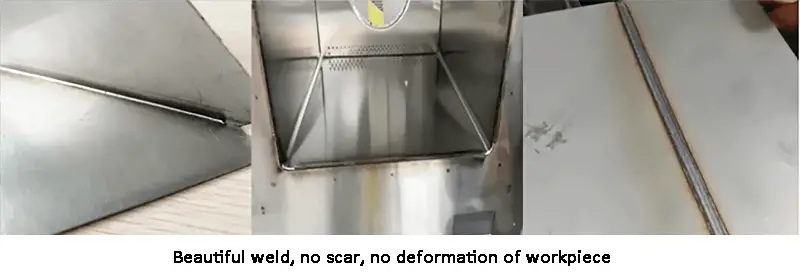
Hand-held laser welding technology has revolutionized metal joining processes with its exceptional ease of operation, aesthetically pleasing welds, rapid welding speeds, and elimination of consumables. This advanced technique effectively supersedes traditional welding methods like tungsten inert gas (TIG) and manual metal arc (MMA) welding, particularly for thin-gauge materials including stainless steel, mild steel, and galvanized sheets, as well as various non-ferrous alloys.
The ergonomic, hand-held design of modern laser welding systems is crucial for their practical implementation, making them ideal for small to medium-scale fabrication shops and specialized welding applications. This portability and flexibility allow for precise manipulation in confined spaces and complex geometries, addressing the diverse needs of custom fabrication and repair work.
By replacing fixed optical paths with a manually operated welding gun, hand-held laser welding machines have transformed the conventional paradigm of laser welding. This innovation enables not only the efficient welding of products such as molds, signage, and culinary equipment but also facilitates on-site and field welding operations, significantly expanding the application scope of laser technology.
The versatility of hand-held laser welding systems extends to a wide array of industries and applications, particularly excelling in joining complex, irregular, and thin-walled components. Key application areas include:
The technology’s ability to produce high-quality, precise welds with minimal heat input and distortion makes it particularly suitable for these applications, where aesthetics, structural integrity, and corrosion resistance are paramount.

Wide Welding Range:
The handheld laser welding machine is equipped with a 5m-10m original optical fiber, significantly expanding operational flexibility. This feature eliminates workbench space constraints, enabling welding operations to be performed outdoors and in remote locations, thus broadening the scope of application.
Ergonomic Design for Enhanced Mobility:
The machine incorporates a mobile pulley system, ensuring ergonomic grip and effortless maneuverability. Its station-free design allows for real-time adjustments, making it adaptable to diverse work environments and scenarios, from confined spaces to large-scale industrial settings.
Versatile Welding Capabilities:
This handheld laser welder demonstrates exceptional versatility, capable of performing welds at any angle. Its repertoire includes overlap welding, butt welding, vertical welding, flat fillet welding, internal and external fillet welding, among others. This multi-angle functionality makes it particularly suited for complex, irregularly shaped, and large workpieces, addressing challenges in various industrial applications.
Superior Weld Quality:
Utilizing advanced hot melt welding technology, the handheld laser welder delivers higher energy density compared to conventional welding methods. This results in superior weld quality characterized by:
Streamlined Post-Weld Processing:
Unlike traditional welding techniques that often necessitate extensive post-weld grinding, the handheld laser welder produces consistently smooth, continuous welds. The absence of fish scales and scarring eliminates the need for subsequent polishing, significantly reducing processing time and labor costs.
Cost-Effective Operation:
The system operates without the need for consumable welding wire, streamlining the welding process and reducing material costs in production and processing. This feature contributes to overall operational efficiency and cost-effectiveness.
Advanced Safety Features:
The machine incorporates multiple safety mechanisms:
These features collectively ensure a high level of operator safety during welding operations.
Enhanced Productivity and Skill Accessibility:
Compared to traditional arc welding, handheld laser welding can reduce processing costs by up to 30%. The system’s user-friendly interface and operation lower the technical barrier for operators, facilitating rapid training and enabling the achievement of high-quality welding results. This accessibility contributes to increased productivity and reduced labor costs across various industrial applications.
With the advancement of the economy and the enhancement of welding technology, there are numerous welding methods available for individuals to select from.
Unlike traditional welding equipment, more and more consumers are opting for laser welding machines in the modern manufacturing industry.
So, is laser welding really that good? To help you comprehend the features of this product better, I would like to highlight the differences between laser welding and traditional welding.
Can laser welding take the place of traditional welding? Let’s examine the welding methods individually.
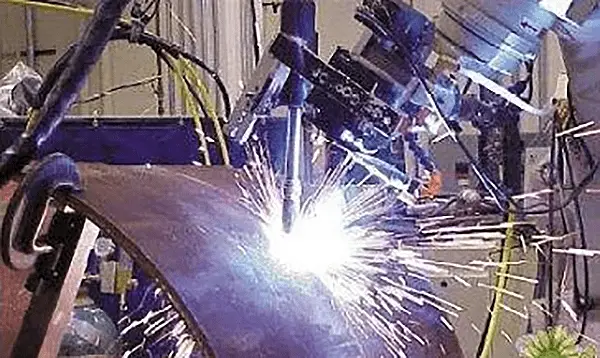
Low-temperature welding in traditional welding is a combined welding process, where the solder is heated by a flame torch and melted in the gap between the metals to be joined.
Typically, the welded joint needs to be buried and preheated.
This method is cumbersome and has several drawbacks, such as being prone to deformation, solder joint breakage, corrosion, etc.
As of now, it is seldom used.
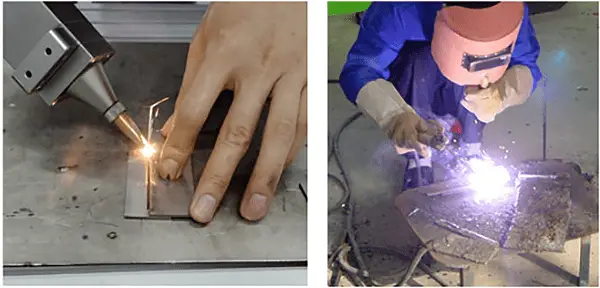
The handheld fiber laser welding machine operates in a handheld welding mode, offering flexibility and convenience, with a longer welding range. The fixed light path is replaced with a handheld welding gun.
The handheld fiber laser welding machine is primarily used for laser welding on large workpieces at a long distance. During welding, the heat-affected area is minimal, preventing deformation, blackening, and marking on the back of the workpiece.
Additionally, the welding depth is substantial, the weld is strong, and the melting is adequate, with no depression on the convex part of the dissolved material or the matrix structure of the solution pool.
What distinguishes hand welding from traditional welding? The first defining feature of laser welding is that it minimizes workpiece deformation and there is virtually no joint gap.
The ratio of depth to width is high, with a ratio of 5:1 for high-power devices and a maximum of 10:1.
The weld strength is high, welding speed is fast, the weld seam is narrow, and the surface finish is usually good, eliminating the need for post-weld cleaning, leading to a more aesthetically pleasing appearance than traditional welding.
Laser welding can weld inaccessible parts and has the capability for non-contact remote welding. However, laser welding is limited to thin plates as it does not have enough penetration and cannot be used for welding the chassis and frame.
This can be achieved through spot welding, but the welding joint of spot welding requires stacking two thin plates together, resulting in a 15mm laminate that not only affects the appearance but also increases the weight of the vehicle.
While laser welding is currently the most advanced body welding technology, it is not feasible for the entire vehicle to adopt laser welding.
Laser welding is a non-contact method that does not require pressure during the operation process. It is fast, efficient, and has a large depth with minimal residual stress and deformation. The welding can be performed at room temperature or in special conditions, such as a closed space, and the equipment is simple and does not emit X-rays.
It can be used to weld refractory materials, such as high melting point metals, and even non-metallic materials such as ceramics and plexiglass. Its flexibility in welding special-shaped materials makes it ideal for non-contact, long-distance welding of inaccessible parts.
By focusing the laser beam, small spots can be achieved, and because it is not affected by magnetic fields and can be accurately positioned, it is suitable for micro-welding in the assembly of micro and small workpieces in mass automatic production.
The laser beam can be split easily in time and space, and can be transferred to multiple workstations via switching devices, allowing for multi-beam simultaneous processing and multi-workstation processing for more precise welding.
As a non-contact process, there are no tool loss or replacement problems, and no need for electrodes, avoiding the issue of electrode pollution or damage.
Laser welding can be automated for high-speed welding and can be controlled by digital or computer means.
Ordinary employees with some basic computer knowledge can operate it, unlike traditional welding machines that require experienced technicians. This saves a significant amount of cost for the enterprise.

Can laser welding replace traditional welding? The answer is yes, as laser welding has more advantages than traditional welding in three key areas.
Laser welding is 2-10 times faster than traditional welding and can save at least two welders per year through the use of a single machine. It requires no special technical skills and can be easily operated by general workers with a simple, intuitive design.
No additional training or guidance is necessary, enabling beautiful welded products to be created without assistance.
The final welded workpiece will be flat, smooth, and aesthetically pleasing, with no need for grinding, polishing, or extensive post-processing. This simplifies the polishing process and saves both time and cost.
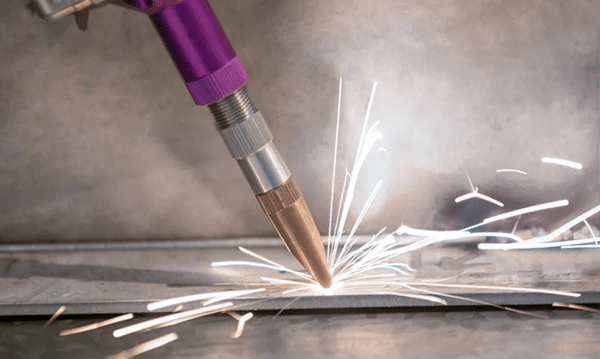
The handheld laser welding machine offers several significant advantages over traditional welding methods:
Simplified Operation: Handheld laser welding machines require minimal training, significantly reducing operator training costs and time-to-productivity. This accessibility allows for a broader range of personnel to perform welding tasks effectively.
Enhanced Speed and Efficiency: Laser welding technology delivers superior processing speeds and efficiency. It produces high-quality, smooth welds that often eliminate the need for post-weld grinding or finishing operations, streamlining the overall manufacturing process.
Versatile Material Compatibility: These machines excel in welding a diverse range of materials, including stainless steel, carbon steel, galvanized steel, and aluminum alloys. This versatility allows for greater flexibility in production and reduces the need for multiple specialized welding systems.
Unparalleled Flexibility: Handheld laser welders can create precise, small-scale joints with minimal heat-affected zones. Their compact design eliminates the need for dedicated welding workstations, offering unmatched mobility for remote or on-site operations. This flexibility is particularly advantageous in confined spaces or complex geometries where traditional welding methods struggle.
Reduced Maintenance Costs: The simplified design and focused energy delivery of laser welding systems result in lower wear on components. This, coupled with the minimal consumables required, translates to significantly reduced maintenance costs and downtime compared to traditional welding equipment.
Exceptional Cost-Performance Ratio: Handheld laser welders offer dual functionality, serving both as mobile welding units and high-precision tools for mold repair when mounted on positioning systems. This versatility makes them an ideal investment for small to medium-sized manufacturers, offering advanced welding capabilities without the high costs associated with larger, stationary laser systems.
Advanced Process Control: Many handheld laser welders incorporate real-time monitoring and adaptive control systems, ensuring consistent weld quality and reducing the reliance on operator skill. This feature minimizes defects and enhances overall product quality.
Environmentally Friendly: Laser welding produces minimal fumes and spatter compared to traditional arc welding methods, creating a cleaner, safer work environment and reducing the need for extensive ventilation systems.
Energy Consumption: Compared to traditional arc welding, a handheld laser welding machine can save about 80% to 90% of electrical energy and reduce the processing cost by about 30%.
Welding Effect: Handheld laser welding can effectively weld dissimilar steel and dissimilar metals. The advantages include high speed, low deformation, and a small heat-affected zone. The resulting weld joint is clean, flat, without or little air holes, and without contamination. The machine is capable of micro-welding and precision welding.
Subsequent Processes: Due to its low heat input during the welding process, a handheld laser welding machine minimizes deformation of the workpiece and results in a beautiful weld surface that requires minimal or no post-treatment. This significantly reduces the labor cost associated with large-scale polishing and leveling processes.
Welding Process for Dissimilar Parts: Argon Arc Welding: This is a type of spot welding, where the workpiece is joined with a welding scar and overlap. The heat input is high, and the workpiece requires significant post-treatment, such as polishing, to remove the scar. An auxiliary welding wire is also necessary.
Handheld Laser Welding: In this process, a continuous laser light is used, without direct contact with the workpiece. The laser produces high temperature light that instantly melts the metal, creating a molten pool. The gas is evenly filled into the weld and cools it. The result is an instantly hot or cold weld with minimal heat effect, creating a beautiful weld without any scars. Depending on the customer’s requirements, the welding part may not need further grinding.

Welding of stainless steel square tube
Thickness Requirements:
Argon arc welding is not suitable for welding thin plates, as it has a high heat effect and cannot weld sheet metal less than 1mm.
Handheld laser welding, on the other hand, is suitable for welding thin plates within 3mm, while the argon arc welding method should be used if the thickness of the sheet metal is over 4mm.
Suitable Process and Function:
Argon arc welding is appropriate for stiffeners or fasteners, such as the welding of 4mm+ plate or pipe, bed body.
It is suitable for reinforcement and bearing purposes that do not require accuracy and beauty. It is capable of dot welding, stacking thickness, and strengthening the workpiece itself, and does not need to focus on appearance.
The added value of the product is also different in this case, and there is no need to choose laser welding.
Handheld laser welding is appropriate for parts that require a beautiful appearance, support parts, and structural parts.
In case of Missing or False Welding:
Argon arc welding: if repeat spot welding is done on the original welding workpiece, there will be pits. The more the welding is repaired, the more likely it is to collapse, resulting in high costs, especially for large parts.
Handheld laser welding: on the other hand, allows for flexible welding repairs and the workpiece can be welded accordingly. Welding wire can also be filled according to actual demand, and slight polishing can be done later.
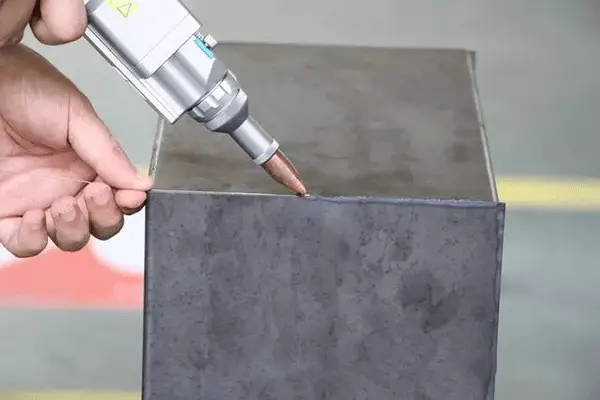
welding with filler wire
Thermal Effects:
Argon Arc Welding: generates high heat and slow heat dissipation, causing the welding spot to be red hot.
Handheld Laser Welding: has no heat effect and fast heat dissipation.
Mobility:
Argon Arc Welding: comes with a motor box (gun body) that is 3 meters long and not easy to move.
Handheld Laser Welding: has a cable length of 5-20 meters, making it easy to move.
Risk Factor:
Argon Arc Welding: generates large sparks that can splash onto the body and face.
Handheld Laser Welding: is risk-free due to the use of laser protective glasses, with no sparks.
Worker Requirements:
Handheld Laser Welding: is easy to operate and requires only 3 hours of training for ordinary workers to start welding.
Efficiency Comparison:
Handheld Laser Welding is 10 times faster than Argon Arc Welding.
Welding Load or Tension:
Different powers corresponding to different thicknesses can be combined with welding thickness and power to achieve full penetration of the workpiece.
The penetration welding will be stronger than the material itself as it is cut off after being heated and becomes more wear-resistant after the second heating and forging.
Customers can make their own tensile test samples, and they may find that the welding place is not broken while the non-welding place breaks first.

Swing head handheld laser welding machine
Welding Temperature: The maximum welding temperature can reach 4000°C, and the heat can be controlled and dissipated instantly, resulting in minimal heat effect.
Single and Double-Sided Welding: Typically, the strength of single-sided welding is not as strong as double-sided welding. The surface of double-sided welding is heated more evenly, resulting in a better appearance and less heat effect and deformation. If you want to achieve greater strength in single-sided welding, the process must be slowed down, resulting in more heat and greater heat effect.
Handheld laser welding vs argon arc welding vs solid YAG welding table
| Type | Argon arc welding | Solid YAG welding | Handheld laser welding | |
|---|---|---|---|---|
| Welding quality | Heat input | Large | Small | Small |
| Workpiece deformation/undercut | Large | Small | Small | |
| Weld seam forming | Fish scale pattern | Fish scale pattern | Smooth | |
| Subsequent treatment | Polish | Polish | / | |
| Operation | Welding speed | Slow | Medium | Fast |
| Operation difficulty | Large | Small | Small | |
| Environmental protection and safety | Personal hazard | Large | Small | Small |
| Environmental pollution | Large | Small | Small | |
| Use cost | Consumables | Welding rod | Laser crystal, xenon lamp | / |
| Energy consumption | Small | Large | Small | |
| Area covered | Small | Large | Small | |
Handheld laser welding machines offer a combination of user-friendly operation and advanced technological capabilities, making them an invaluable asset in modern metal fabrication. These devices are designed for ease of use, allowing operators with minimal training to achieve high-quality welds, thus reducing overall training costs and enhancing workforce flexibility.
The efficiency of these machines is remarkable, characterized by their high welding capacity and rapid welding speeds. They produce precise, aesthetically pleasing welds that often eliminate the need for post-weld grinding or finishing processes, thereby streamlining production workflows and reducing labor costs.
One of the key advantages of handheld laser welding technology is its versatility in material compatibility. It excels in welding a wide range of metals, including but not limited to stainless steel, carbon steel, galvanized steel, and aluminum alloys. This adaptability makes it an ideal solution for diverse manufacturing environments and multi-material applications.
The laser welding process generates a highly focused energy beam, resulting in a small heat-affected zone (HAZ) and minimal thermal distortion. This precision allows for welding of thin materials and intricate components without compromising structural integrity. The compact nature of the welding spot also enables welding in tight or hard-to-reach areas, eliminating the need for dedicated welding workbenches and conserving valuable shop floor space.
Equipped with interchangeable laser welding heads, these handheld devices offer exceptional flexibility in tackling various welding tasks. The modular design allows for cost-effective replacement of accessories and easy adaptation to different welding requirements, enhancing the machine’s longevity and versatility.
Furthermore, recent advancements in laser technology have led to improved energy efficiency and reduced power consumption compared to traditional welding methods. This not only lowers operational costs but also aligns with sustainable manufacturing practices, making handheld laser welding an environmentally conscious choice for modern fabrication facilities.
Handheld laser welding has emerged as a transformative technology in green remanufacturing, offering significant advantages over conventional welding methods. Its high-speed operation, precision capabilities, and energy efficiency make it an indispensable tool across various sectors of the global economy, including microelectronics, automotive manufacturing, aerospace engineering, and industrial machinery production.
As a key enabler of intelligent manufacturing, laser welding technology, particularly in its handheld form, excels in complex and irregular welding scenarios where traditional fixtures are impractical. This versatility is especially valuable in applications such as sheet metal fabrication, chassis construction, fluid containment systems, electrical enclosures, modular kitchen units, and architectural metalwork for doors and windows.
The technology has rapidly gained traction in thin metal joining processes, effectively supplanting traditional argon arc and electric welding methods for materials like stainless steel, mild steel, and aluminum alloys. Its ability to produce high-quality, precise welds with minimal heat-affected zones has made it particularly attractive for industries demanding superior finish and structural integrity.
The exponential growth of the electric vehicle (EV) market has further catalyzed the adoption of handheld laser welding, especially in the production of advanced battery systems. The technology’s capacity for creating hermetic seals and its compatibility with automation have positioned it as a critical process in EV battery manufacturing, where weld quality directly impacts vehicle performance and safety.
Industry analysts project a bright future for handheld laser welding as it continues to penetrate key sectors. With ongoing standardization efforts, the technology is poised for widespread integration in critical industries such as rail transportation, aerospace engineering, automotive production, and medical device manufacturing. Its potential to enhance productivity, improve weld quality, and reduce environmental impact aligns well with the global push towards sustainable and efficient manufacturing practices.
As the technology matures, we can expect to see further innovations in beam delivery systems, real-time quality monitoring, and integration with collaborative robots, further expanding its applications and cementing its role in the future of advanced manufacturing.
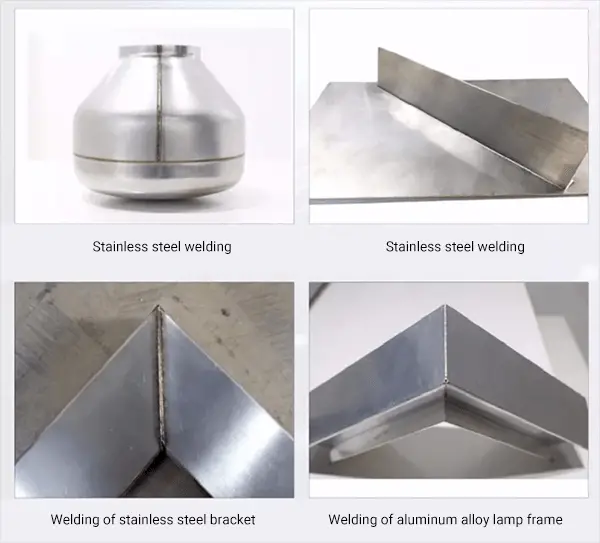
The evolution of handheld laser welding technology has led to significant advancements, with fourth-generation machines now available in the market. These cutting-edge devices offer a combination of precision, efficiency, and versatility that is reshaping the welding industry.
One of the key advantages of modern handheld laser welders is their adaptability. The welding power can be fine-tuned, and both the size and width of the weld bead can be adjusted to suit various materials and joint configurations. This flexibility not only enhances convenience but also contributes to substantial cost savings by optimizing material usage and reducing rework.
The lasers employed in these machines are sourced from reputable manufacturers, known for their high-quality optical components. These lasers boast impressive characteristics, including high energy efficiency, stable beam output, and an extended service life of up to 100,000 hours. This longevity significantly reduces maintenance downtime and replacement costs over the machine’s lifespan.
Ergonomics and portability have been prioritized in the design of these welders. The sleek, user-friendly form factor has garnered positive feedback from operators across various industries. The integration of a 10-meter optical fiber cable connecting the welding gun to the main unit allows for exceptional maneuverability. This extended reach enables welding in diverse environments, including outdoor locations, expanding the potential applications beyond traditional workshop settings.
When compared to conventional arc welding methods, handheld laser welding offers several distinct advantages:
The simplicity of operation, combined with the machine’s capabilities, has made handheld laser welding accessible to a broader range of users, regardless of physical strength or prior welding experience. This democratization of advanced welding technology has the potential to address skilled labor shortages in the industry.
In conclusion, handheld laser welding machines have garnered widespread acclaim in the welding sector due to their user-friendly operation, cost-effectiveness, and superior weld quality. As this technology continues to evolve and become more accessible, it is poised to significantly impact the welding market by improving productivity, reducing costs, and opening up new possibilities for precision joining across various industries.
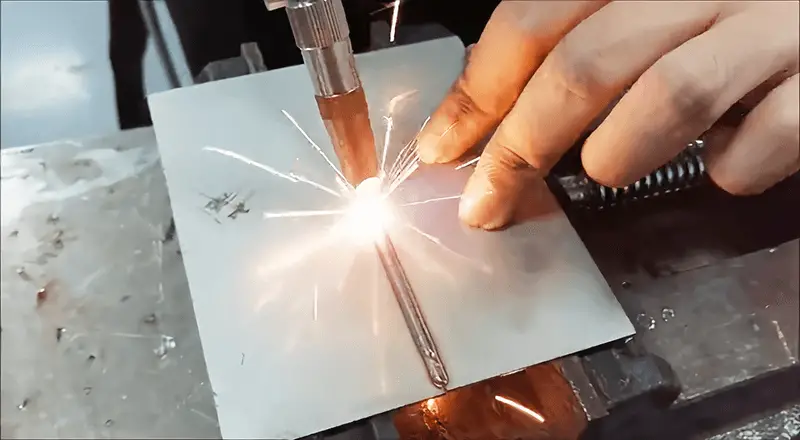
Handheld laser welding machines offer significant advantages for stainless steel welding, revolutionizing the fabrication process with their efficiency and versatility. These systems substantially reduce workpiece preparation requirements and minimize the need for extensive operator expertise, streamlining the overall welding workflow.
For businesses engaged in stainless steel product manufacturing, the simplicity of operation is paramount. Operators need only adjust welding parameters based on the stainless steel plate thickness, eliminating the need for additional filler materials or consumables. This not only reduces material costs but also simplifies inventory management and reduces waste.
The handheld laser welding machine excels in its penetration capabilities, producing high-quality, aesthetically pleasing, and structurally sound welds. Its efficiency is particularly notable in welding stainless steel architectural elements such as doors, windows, and handrails, where it requires lower laser power compared to traditional methods. This reduced power requirement enhances energy efficiency and operational safety.
Flexibility in application is a key advantage, facilitated by the welding head’s 5-meter imported optical fiber. This feature enables seamless outdoor welding operations, expanding the range of possible work environments and applications. The ergonomic design of the handheld welding gun allows for multi-angle welding on complex geometries, while the dual optical path with intelligent switching and uniform time-division energy distribution ensures consistent weld quality regardless of position.
The system’s versatility extends to its suitability for spot welding on intricate components and devices. Furthermore, its potential for automation through integration with robotic manipulators opens up possibilities for increased productivity and precision in high-volume production scenarios.
The material compatibility of this handheld laser welding machine is extensive, encompassing not only stainless steel but also carbon steel and various other alloys. This broad applicability makes it an invaluable tool across diverse industries, including:
While handheld laser welding systems are gaining traction in the industry, several challenges persist. Current market offerings from equipment manufacturers predominantly feature continuous fiber lasers with power outputs ranging from 200W to 1500W, providing a balance between portability and welding capability.
Safety remains a paramount concern in handheld laser welding operations. Operators must undergo rigorous training to mitigate risks associated with high-power laser beams. The potential for severe burns or fire hazards necessitates strict adherence to safety protocols, including never directing the laser towards people or surrounding objects. This requirement for heightened situational awareness can impact workflow efficiency and operator comfort.
The welding process, although focused on the workpiece, generates high-intensity reflections that pose significant ocular hazards. Consequently, operators are required to wear specialized protective eyewear with appropriate optical density ratings. These goggles must effectively filter the specific wavelengths emitted by the laser while maintaining sufficient visibility for precise welding operations.
Additional challenges include:
Addressing these challenges through technological advancements and improved safety measures is crucial for the widespread adoption of handheld laser welding systems. Innovations in beam shaping, adaptive optics, and intelligent process monitoring could significantly enhance both safety and performance. As these issues are resolved, the market for handheld laser welding systems is poised for rapid growth, driven by their potential to revolutionize on-site welding operations across various industries.
1. Application in the kitchenware industry
Handheld kitchenware laser welding equipment can save approximately 80% to 90% of electric energy. It also offers a cost reduction of around 30% compared to arc welding.
Additionally, this equipment is capable of welding dissimilar steel and dissimilar metals and can easily achieve mechanization and automation.
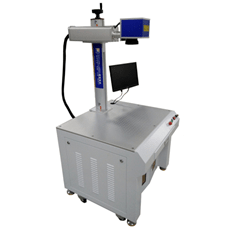
2. Application in the sheet metal processing field
In the field of sheet metal processing, laser welding has clear advantages compared to traditional argon arc welding.
These advantages include higher efficiency, minimal thermal deformation, a more attractive appearance, increased strength, no need for post-weld polishing, the ability to perform seamless butt welding, bending, stamping, and cutting.
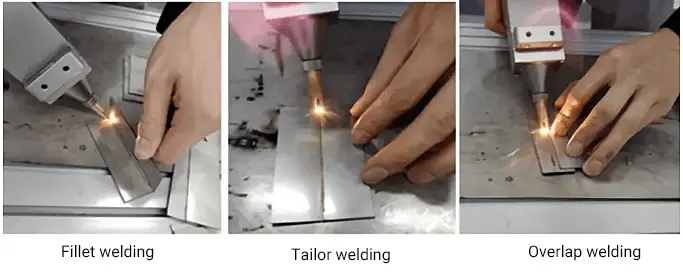
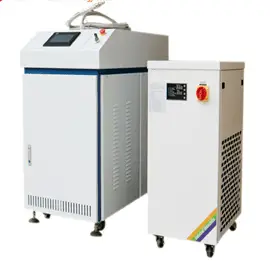
3. Application in stainless steel bathroom processing field
In the field of welding stainless steel sanitary ware, handheld laser welding offers seamless splicing of fittings such as faucet and sink outlets with bright and attractive welding seams.
The process allows for 360-degree welding of right-angle fillets, making it convenient and easy to operate.

The basic operation environment of the product is as follows:
| Voltage | Three-phase five wire 380V ± 10% 50 / 60Hz AC |
| Power supply capacity | Not less than 5KW |
| Setting environment | Smooth, without vibration and impact |
| Working environment temperature | 10℃~40℃ |
| Working environment humidity | <70% |
| Weight (excluding package) | 300kg |
Warning:
Prior to using the laser, ensure a proper grounding connection.
The product does not come with built-in components, all maintenance must be conducted under the guidance of the company’s technical staff.
To prevent electric shock, do not tamper with the label or remove the cover. Any damage to the product will not be covered under warranty.
The laser’s output head is connected to an optical cable. Carefully inspect the output head to avoid contamination from dust or other debris.
When cleaning the output lens, use specialized lens paper.
Abnormal operation may cause damage to the laser if not used according to the instructions in this manual.
It is forbidden to install the output head while the laser is in use.
Do not gaze directly into the output head. When operating the machine, make sure to wear proper laser protection.
Precautions
(1) Before connecting the laser welding machine to the AC power supply, it is important to make sure that the correct 380V AC voltage is used. Failure to do so can cause irreparable damage to the laser.
(2) Operating the laser outside of the control or adjustment methods specified in this manual can also result in damage.
(3) Maintaining a clean output lens is crucial for good collimation of the laser output. Any damage to the lens will result in irreparable damage to the laser.
(4) When not in use, it is important to cover the collimator with its protective cap and not to touch the lens at the output end. If cleaning is necessary, special lens paper and alcohol should be used.
(5) Any loss of laser power due to incorrect operation, as specified above, will not be covered under the warranty.
Technical parameters of handheld laser welding machine
| Model | ||
|---|---|---|
| Optical characteristics | Testing environment | |
| Rated output power (W) | 1000-2000 | |
| Working mode | Continuous / modulation | |
| Output spot | Rotary motor ring variable multi spot | |
| Power regulation range (%) | 10~100 | |
| Central wavelength (nm) | 1080 | Rated output power |
| Output power instability | <3% | Rated output power; Continuous operation time: ≥ 5hrs; Working temperature: 25 ℃ |
| Modulation frequency (Hz) | 50~5k | Rated output power |
| Red light indicates output power (mW) | 0.5~1 | |
Optical output characteristics of output head
| Beam quality (BPP, mm•mrad) | <2 | Rated output power |
|---|---|---|
| Numerical aperture | 0.2 | |
| Fiber core diameter (μm) | 50 | 25, 100, 200 Optional |
| Output fiber length (m) | 10-15 |
Electrical properties
| Working voltage | Three phase five wire system 380V±10% 50/60Hz AC |
| Maximum power consumption (W) | 5000 |
| Control mode | Hyper terminal /RS-232/AD |
Other features
| Dimensions (W×H×D) | |
| Weight (kg) | <300 |
| Temperature range of working environment (℃) | 10~40 |
| Humidity range of working environment (%) | <70 |
| Storage temperature (℃) | -10~60 |
| Cooling mode | water cooling |
1) Cooling system water temperature setting:
2) Coolant requirements:
Purified water should be used as the cooling water and it is recommended to also drink purified water.
To avoid clogging in the chiller’s water caused by mold growth, it is suggested to add 10% ethanol when adding pure water.
When the equipment’s ambient temperature is between -10℃ and 0℃, a 30% ethanol solution should be used and replaced every two months.
If the ambient temperature of the equipment is below -10℃, a double system chiller with heating function must be utilized and continuous operation of the cooling system must be ensured.
Other requirements of the cooling system:
If the laser is not used for an extended period, it is important to drain the cooling water inside the cooling system and the laser to prevent irreparable damage to the laser equipment.
 | It is important to set the water temperature of the cooling system correctly in accordance with the ambient temperature. If the water temperature is set too high, it may cause the laser to malfunction. On the other hand, if the water temperature is set too low, condensed water may form in the laser or its output head, resulting in irreparable damage to the laser equipment. |
 | Before starting the laser, it is important to ensure that the cooling system is functioning properly and that the water temperature has reached the appropriate level. (In summer: 29 ± 0.5°C; In winter: 25 ± 0.5°C) |
Installation precautions
(1) Position the equipment in a horizontal location and secure it as needed.
(2) Before turning on the power, make sure the power supply is stable (220-380V AC ± 10%, 50/60Hz) and the grounding wire is in good condition.
(3) Connect all power and control lines while the power is off.
(4) Connect the cooling system to the laser and output head following the water inlet and outlet identification.
(5) Inspect the laser output head and clean it if necessary before installing it in the equipment. If dust is found on the output head, do not install and operate the laser until it has been cleaned.
(6) Handle the Yellow/metal armored protective sleeve with care during jumper installation, avoiding damage to the optical fiber by not stepping on it, squeezing it, or over-bending it.
(7) When installing or removing the laser output head, handle it with care and avoid vibration.
(8) Maintain a clean surrounding environment during the installation of the jumper output head to avoid pollution of the output head. For example, avoid using electric fans for heat dissipation in the summer when it is hot to prevent large amounts of dust in the air.
(9) The minimum bending radius of the laser transmission fiber should not be less than 20 cm during transportation and storage when the laser is not in use. When the laser is in the output state, the minimum bending radius should not be less than 30 cm.
 | All the control lines of the laser should be connected while the power is off to avoid any potential damage to the laser caused by electrically charged installation of the control lines. |
 | The laser output fiber should be kept in a relaxed position as much as possible, and twisting of the output fiber is prohibited. If the diameter of the fiber is too small, it can cause damage to the laser output. |
 | In the process of installing and removing the laser output head, handle it with care and avoid any vibration. Before assembling the laser output head, ensure that the optical lens and cutting head cavity are clean and free of any pollutants. Take good care of the protective cap of the output head to prevent contamination. Otherwise, the protective cap can cause indirect contamination of the output head. |
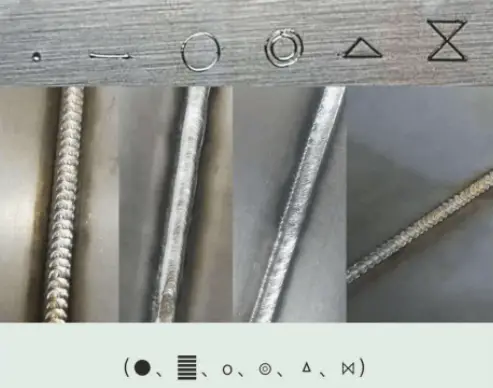
(1) The device offers three new beam shapes and six beam shapes for selection, allowing for customization to meet the needs of different beam shapes for internal and external corner welding, flat welding, and angle welding.
(2) The Qilin double pendulum allows for adjustable energy density, effectively welding within a range of 0.2 to 5mm.
| No. | Model | Advantages |
| 1 | Spot | Small spot, strong energy, suitable for penetration welding and cutting. |
| 2 | Line | The width of the welding can be adjusted, and it is capable of penetrating thicker plates to a certain extent. This makes it suitable for external corner welding, tailor welding, and wire-feeding welding. |
| 3 | Circle | The diameter can be adjusted, resulting in a uniform distribution of energy density. The benefits of using high-frequency welding for thin plates are clear. |
| 4 | Double O | The adjustable diameter serves the primary purpose of reducing hollow spots, enlarging the spot size, and ensuring more uniform light radiation across the plate. This feature makes it suitable for all types of angle welding. |
| 5 | Triangle | The adjustable width helps reduce hollow spots and ensures that the three sides of the plate receive equal heating. Additionally, incorporating wire feeding welding allows for a reduction in frequency and produces a fish scale shaped welding spot, which is a significant improvement over single swing welding joints. |
| 6 | 8 style | Building upon a triangular design, the light spot is increased further, allowing for multiple heating of the plate. This feature makes it suitable for use in large-width welding. |
Laser Head Status Not Displayed:
No Conductive State Display or Intermittent Light Output During Welding:
Gas Cannot Be Controlled:
Protective Lens Easily Burns:
Welding Torch Head Overheated:
Touch Screen Parameters Cannot Be Modified:
Cleaning the Welding Gun Head:
Replacing the Protective Lens:
Handling the Welding Gun Head:
Using the Product:
Warning
Maintenance:
The circuit board is dead
Unit maintenance
Please blow the condenser for a long time:

Water Tank Maintenance:
Power Supply Maintenance:
Safety precautions
Before First Installation and Power-On, Carefully Check Wiring and Voltage for Correctness
The personnel responsible for the unit’s installation must ensure proper installation to prevent electric leaks, water leaks, or fire. If the unit needs to be removed and reinstalled, it is recommended to contact a professional.
Do Not Switch the Unit by Pulling Out the Power Plug through the Controller’s Switch System. Excessive current could burn the plug and trip the circuit, posing a safety hazard.
Ensure that the power supply is securely connected and the wire insulation is intact. Loose or broken wires could lead to electric shock, short-circuits, or fire.
Avoid putting foreign objects such as fingers or sticks into the unit’s air outlet, as this could cause damage to the unit or personal injury.
Provide adequate ventilation during operation of the unit.
Do not stand on or place objects on the unit.
Do not operate the unit with wet hands, as this could lead to electric shock.
The unit must be properly grounded. The ground wire should not be connected to the gas pipe, water pipe, or telephone line, as poor grounding could result in electric shock.
Ensure that a current protection device is installed to prevent electric shock.
If any unusual phenomena (such as a burning smell) are observed, immediately cut off the power supply and contact the economic department for solutions.

Operators of handheld laser welding machines must undergo comprehensive professional training, encompassing system indicator interpretation, control panel operation, and fundamental equipment knowledge. This training ensures safe and efficient operation of the sophisticated welding technology.
Prior to operation, conduct a thorough inspection of the machine’s detection work trunking and wiring for any signs of damage or exposure. This critical pre-operation check safeguards against potential electrical hazards and ensures optimal performance.
Maintain a clear workspace by strictly prohibiting the placement of extraneous items or tools on the robot body, external shaft, gun cleaning station, or water cooler. This practice prevents interference with moving parts and maintains system integrity.
Enforce a stringent policy against storing flammable or liquid substances in the operating room. Maintain an ambient temperature below 25°C and ensure the area is free from any leaks. These measures are crucial for fire prevention and optimal equipment function.
Implement a rigorous schedule of regular tests and inspections to proactively identify and address potential issues before they escalate into major problems.
The forced air cooling system in the welding machine is prone to dust accumulation. To mitigate this, utilize clean, dry compressed air to periodically remove dust from the machine’s interior components. This maintenance task is vital for preventing overheating and ensuring consistent performance.
Regularly inspect and verify the integrity of power wiring connections. Loose or corroded connections can lead to electrical inefficiencies or safety hazards.
During annual maintenance, conduct a comprehensive inspection. Replace any faulty components, repair damaged casing, and reinforce areas with deteriorating insulation. This proactive approach prevents unexpected breakdowns and extends equipment lifespan.
Perform routine checks on consumable parts such as conductive nozzles, replacing them as needed. Clean and replace the spring hose periodically to maintain optimal gas flow and prevent contamination. Additionally, inspect insulating rings for signs of wear or damage.
Adhering to this systematic maintenance regimen minimizes the occurrence of welding faults. While these procedures require time and resources, they significantly extend the service life of the welding machine, enhance operational efficiency, ensure consistent performance, and bolster overall safety.
It is imperative to emphasize that safety protocols must be rigorously followed during the operation of handheld laser welding machines. This includes wearing appropriate personal protective equipment (PPE) such as laser-safe goggles, heat-resistant gloves, and flame-retardant clothing. Operators should also be trained in laser safety procedures and be aware of potential hazards such as reflected laser beams and fume exposure.
Welding speed significantly affects the energy absorbed by the weld per unit of time, thereby influencing the weld’s penetration depth and width, as well as its appearance. This brief overview discusses the impact of welding speed on weld quality, providing a reference for process adjustments.
The speed primarily affects penetration depth and width, mainly relating to the linear energy density. Generally, as the laser welding speed increases, the fused area and width decrease. This can be understood as the increase in laser welding speed leading to a reduced dwell time of the laser on the surface of the workpiece. With the shorter laser dwell time, the heat conduction area decreases, resulting in a smaller fusion zone and heat-affected zone.


Furthermore, welding speed affects the appearance of the weld, often resulting in a rough, “V-shaped” fish scale pattern on the surface, with discoloration and minimal to no reinforcement, resulting in an unfilled weld.

Table Handheld Laser Welding Thickness & Speed Chart (800W-1500W)
| Metals | Thickness (mm) | Welding form | 800W welding efficiency (mm/s) | 1000W welding efficiency (mm/s) | 1500W welding efficiency (mm/s) |
| Stainless steel | 1 | Butt welding | 45 | 55 | 70 |
| Stainless steel | 2 | Butt welding | 16 | 35 | 45 |
| Stainless steel | 3 | Butt welding | / | 18 | 35 |
| Stainless steel | 4 | Butt welding | / | / | 15 |
| Carbon steel | 1 | Butt welding | 40 | 48 | 62 |
| Carbon steel | 2 | Butt welding | 12 | 23 | 35 |
| Carbon steel | 3 | Butt welding | / | 18 | 25 |
| Carbon steel | 4 | Butt welding | / | / | / |
| 1-3 series aluminum alloy | 1 | Butt welding | 32 | 40 | 70 |
| 1-3 series aluminum alloy | 2 | Butt welding | / | 20 | 35 |
| 4-7 series aluminum alloy | 1 | Butt welding | 18 | 35 | 60 |
| 4-7 series aluminum alloy | 2 | Butt welding | / | / | 25 |
Note: The above performance parameters are standard test data, and due to the complexity of practical applications, there may be differences in the data.
Improper speed selection can lead to defects in laser welding, which is a continuous process of melting and solidification. As the welding speed increases, the cooling rate of the molten metal also increases. This accelerated solidification makes it difficult for the metal to spread, resulting in humping defects. These humps increase as the welding speed rises, indirectly limiting the welding speed.
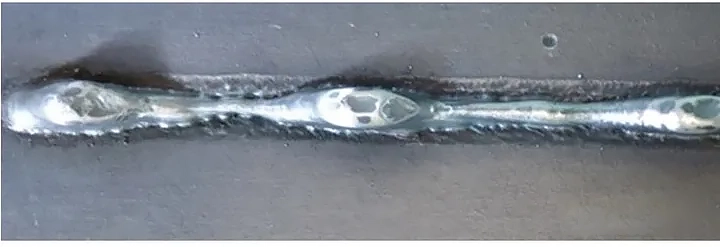
Solutions to Humping Prevention:
1. Utilize lasers with a smaller core diameter or select collimating focusing heads to reduce the spot size, concentrating the energy more effectively.
The mechanism is as follows: lasers with a smaller spot diameter can shorten the distance between the laser heat source and the liquid metal flow convergence point, facilitating the spread of liquid metal and suppressing humping;

2. Employ a dual-beam laser approach with one beam ahead of the other, or use ring-shaped spots, multi-wavelength fiber semiconductor composite welding, which can significantly increase the maximum welding speed without causing humping by over 40% compared to single-beam laser speeds.
Typically, one of the two laser beams is responsible for preheating and post-processing, and the other for melting depth. This reduces the cooling rate of the liquid metal around the keyhole, decreases the temperature gradient, lowers the surface tension of the liquid metal around the keyhole, and enhances the spreading ability of the liquid metal, thereby preventing humping.

When seeking reliable laser welding machine manufacturers, it’s crucial to consider several factors to ensure you select a supplier that meets your specific manufacturing needs and quality standards. Here’s a comprehensive guide to help you in your search:
Technology and Innovation:
Look for manufacturers that consistently invest in research and development, offering cutting-edge laser welding technologies. Advanced features such as real-time weld monitoring, adaptive control systems, and Industry 4.0 compatibility can significantly enhance your production capabilities.
Machine Range and Customization:
Reputable manufacturers typically offer a diverse range of laser welding machines, including:
Industry Experience and Reputation:
Evaluate the manufacturer’s track record in your specific industry. Look for case studies, client testimonials, and industry certifications that demonstrate their expertise and reliability.
Technical Support and Training:
Ensure the manufacturer provides comprehensive technical support, including:
Global Presence and Local Support:
For international buyers, consider manufacturers with a global presence and local support networks to ensure timely assistance and spare parts availability.
Quality Assurance and Certifications:
Verify that the manufacturer adheres to international quality standards such as ISO 9001 and possesses relevant industry-specific certifications.
Cost-Effectiveness and ROI:
While initial cost is important, focus on the total cost of ownership, including energy efficiency, maintenance requirements, and expected machine lifespan.
Sustainability Practices:
With increasing emphasis on environmental responsibility, consider manufacturers that prioritize energy-efficient designs and sustainable manufacturing practices.
Some renowned laser welding machine manufacturers to consider include:
When evaluating these and other manufacturers, request detailed specifications, arrange for machine demonstrations, and if possible, conduct site visits to see the equipment in operation. Additionally, consult with industry peers and attend trade shows to gather firsthand information on the latest laser welding technologies and manufacturer reputations.
By thoroughly assessing these factors, you can identify a laser welding machine manufacturer that not only meets your current production requirements but also supports your long-term manufacturing goals and growth strategies.

